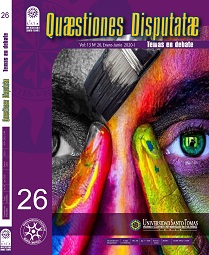Of prophets and hermits: lights and shadows
Main Article Content
Abstract
The mystical experience has been present at all times and has been anchored to religions, which have taken moments of ecstasy from different people to deepen their dogmatic or strengthen their believers. In spite of the negative that can be said about this matter, we have to notice the clearly differentiated aspects at the moment of speaking of the ecstasy in which this experience or experience fall: on the one hand we have the prophecy, on the other, the eremiritarismi. In the first, feeling predominates, in the second knowledge does. The prophet and the hermit must arrive at the same place: an experience that links them to their God or their Deity. Beyond what can be done according to each religious institution, we must note that both routes have elements in common and clearly denoted differences. Here is the objective or our article: to show the lights and shadows that may exist in the face of two types of divine experiences that, despite having a common horizon, are radically opposed. Our approach is limited to what is termed as phenomenology of religion.
Article Details
How to Cite
Escobar-Gómez, J. A. (2020). Of prophets and hermits: lights and shadows. Quaestiones Disputatae: Temas En Debate, 13(26), 107-134. Retrieved from http://revistas.ustatunja.edu.co/index.php/qdisputatae/article/view/2011
Section
Articulos Num.26
De acuerdo a la Licencia Creative Commons Atribución-No Comercial-Sin Derivar 4.0 Internacional, se autoriza leer, descargar, copiar, distribuir, imprimir, buscar o enlazar los textos completos de estos artículos, siempre y cuando se conceda el crédito a los autores de los textos y a la Revista Quaestiones Disputatae: temas en debate, como fuente de publicación original. No se permite el uso comercial de copia o distribución de contenidos, así como tampoco la adaptación, derivación o transformación alguna de estos sin la autorización previa de los autores y de la dirección de Quaestiones Disputatae: temas en debate.

Esta obra está bajo una licencia de Creative Commons Reconocimiento-NoComercial-SinObraDerivada 4.0 Internacional.
References
Barrientos, J-P (2019). Dejad que los niños vengan a mí. Editorial Planeta: Bogotá - Colombia.
Ficino, M (1986). De amore. Barcelona: editorial Tecnos.
Gonzáles Suárez, L (2015). La doctrina de Tomás de Aquino sobre la analogía como recurso para el conocimiento natural de Dios. Una meditación filosófica sobre sus límites y sus alcances. En: Perseitas, Vol. 3. Núm. 2. Pp. 154 – 174.
________________ (2016). Presencia escondida de Dios en el centro del alma. Reflexiones sobre la antropología mística de San Juan de la Cruz. En: Análisis, vol. 48, núm. 89. Pp. 391 – 409.
______________ (2018). La presencia de Dios en el castillo interior. En torno a la complementariedad de la antropología mística de Santa Teresa de Jesús y la antropología fenomenológica de Edith Stein. En; Valenciana. Número 21. Pp. 127 - 151.
McCulloch, D (2011). Historia de la Cristiandad. Madrid: Editorial Debate.
Montaigne, M (2010). Ensayos escogidos. Medellín: Editorial Universidad de Antioquia.
Rodríguez, P (2012). Mentiras fundamentales de la Iglesia Católica. Editorial De Bolsillo: Barcelona - España.
Sáenz Obregón, J (2016) Comp., and trad. Conversando con dios. Selección de Poesía mística de la India y Persia: siglos X a XVII. Medellín: Editorial Universidad de Antioquia.
Schopenhauer, A (2009). El mundo como Voluntad y Representación. Madrid: Editorial Trotta.
Soto Posada, G (2007). Filosofía Medieval. Medellín: Sociedad San Pablo y Universidad Pedagógica Nacional.
Vargas, W (2013). El problema de la muerte en el estoicismo romano: Epicteto, Séneca y Marco Aurelio. En Revista de psiquiatría Universitaria Núm. 9. Vol. 2. Pp. 173 - 177.
Otto, R (2014). Mística de Oriente y Occidente. Sankara y Eckhart. Madrid: Editorial Trotta.
Ficino, M (1986). De amore. Barcelona: editorial Tecnos.
Gonzáles Suárez, L (2015). La doctrina de Tomás de Aquino sobre la analogía como recurso para el conocimiento natural de Dios. Una meditación filosófica sobre sus límites y sus alcances. En: Perseitas, Vol. 3. Núm. 2. Pp. 154 – 174.
________________ (2016). Presencia escondida de Dios en el centro del alma. Reflexiones sobre la antropología mística de San Juan de la Cruz. En: Análisis, vol. 48, núm. 89. Pp. 391 – 409.
______________ (2018). La presencia de Dios en el castillo interior. En torno a la complementariedad de la antropología mística de Santa Teresa de Jesús y la antropología fenomenológica de Edith Stein. En; Valenciana. Número 21. Pp. 127 - 151.
McCulloch, D (2011). Historia de la Cristiandad. Madrid: Editorial Debate.
Montaigne, M (2010). Ensayos escogidos. Medellín: Editorial Universidad de Antioquia.
Rodríguez, P (2012). Mentiras fundamentales de la Iglesia Católica. Editorial De Bolsillo: Barcelona - España.
Sáenz Obregón, J (2016) Comp., and trad. Conversando con dios. Selección de Poesía mística de la India y Persia: siglos X a XVII. Medellín: Editorial Universidad de Antioquia.
Schopenhauer, A (2009). El mundo como Voluntad y Representación. Madrid: Editorial Trotta.
Soto Posada, G (2007). Filosofía Medieval. Medellín: Sociedad San Pablo y Universidad Pedagógica Nacional.
Vargas, W (2013). El problema de la muerte en el estoicismo romano: Epicteto, Séneca y Marco Aurelio. En Revista de psiquiatría Universitaria Núm. 9. Vol. 2. Pp. 173 - 177.
Otto, R (2014). Mística de Oriente y Occidente. Sankara y Eckhart. Madrid: Editorial Trotta.

